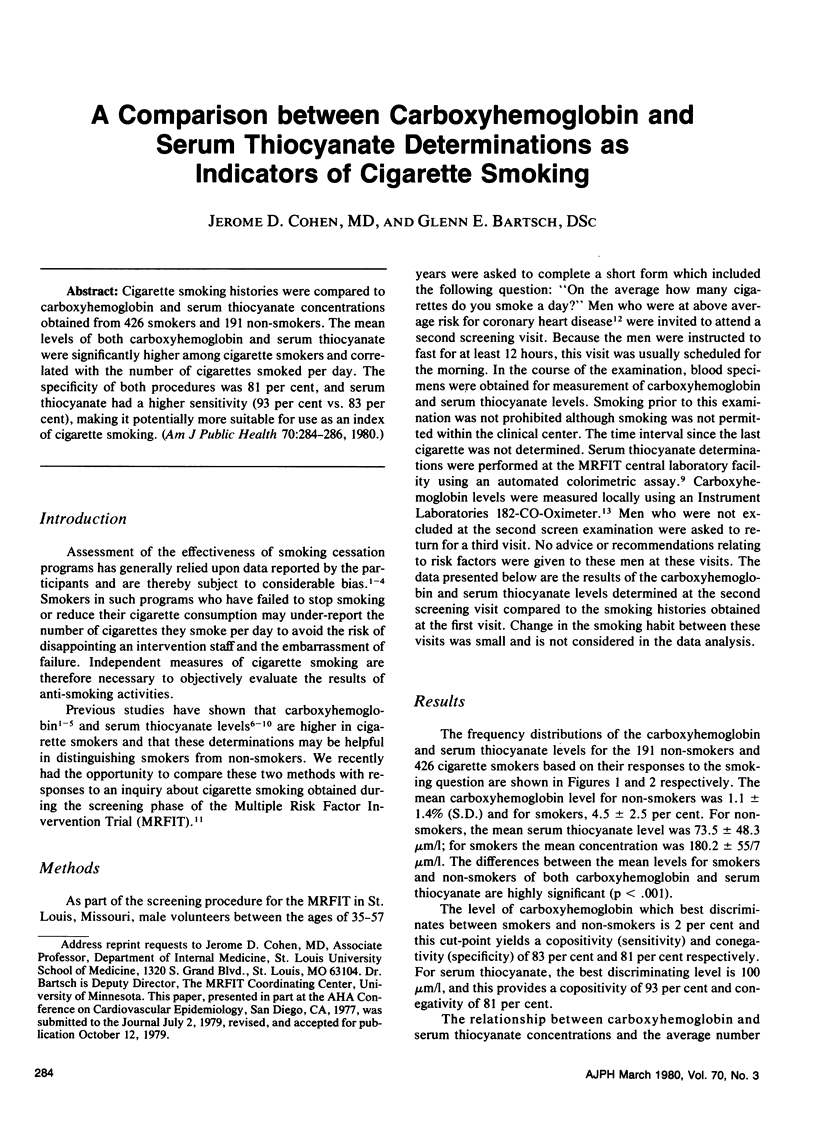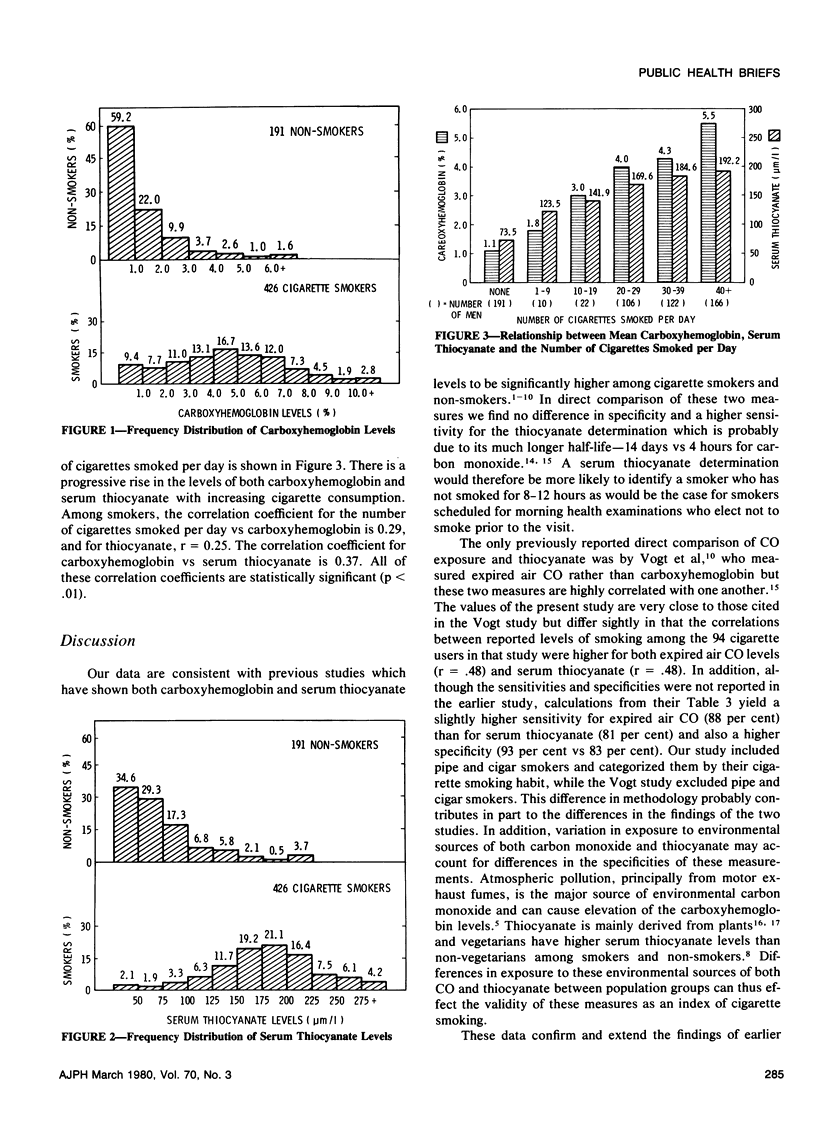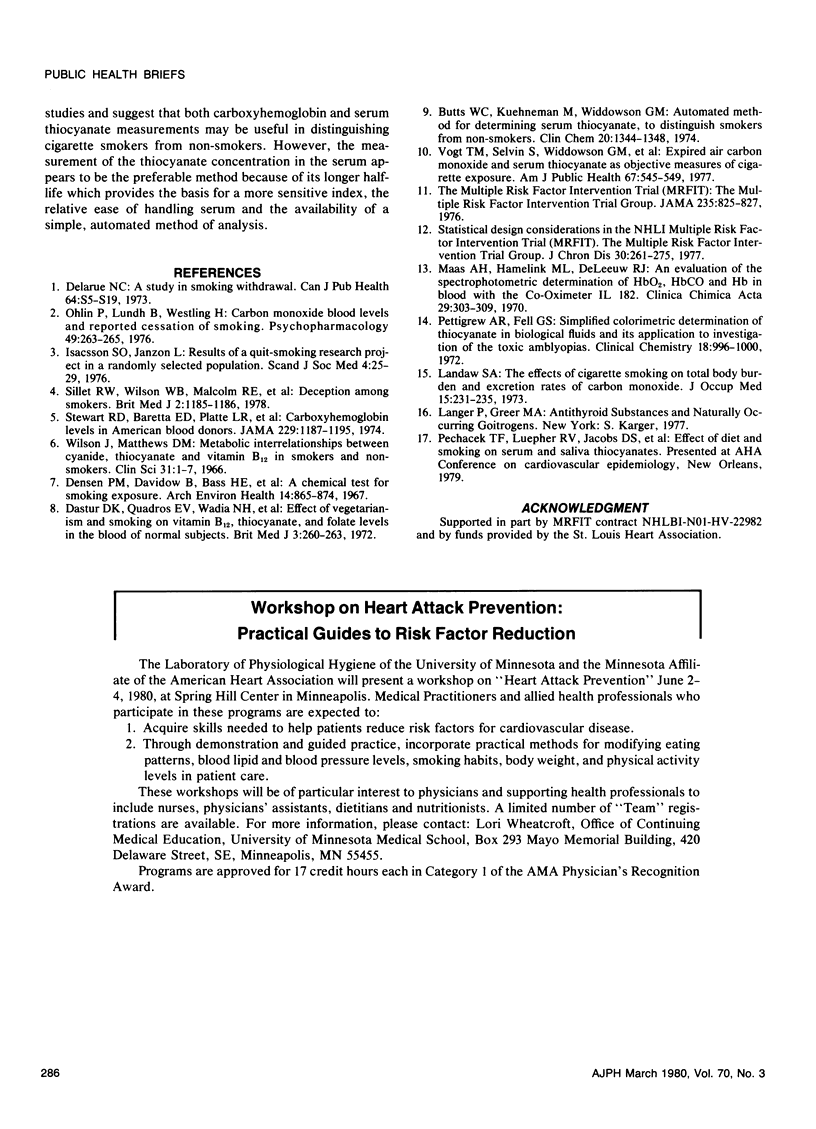Abstract
Cigarette smoking histories were compared to carboxyhemoglobin and serum thiocyanate concentrations obtained from 426 smokers and 191 non-smokers. The mean levels of both carboxyhemoglobin and serum thiocyanate wefe significantly higher among cigarette smokers and correlated with number of cigarettes smoked per day. The specificity of both procedures was 81 per cent, and serum thiocyanate had a higher sensitivity (93 per cent vs. 83 per cent), making it potentially more suitable for use as an index of cigarette smoking.
Full text
PDF


Selected References
These references are in PubMed. This may not be the complete list of references from this article.
- Butts W. C., Kueheman M., Widdowson G. M. Automated method for determining serum thiocyanate, to distinguish smokers from nonsmokers. Clin Chem. 1974 Oct;20(10):1344–1348. [PubMed] [Google Scholar]
- Dastur D. K., Quadros E. V., Wadia N. H., Desai M. M., Bharucha E. P. Effect of vegetarianism and smoking on vitamin B12, thiocyanate, and folate levels in the blood of normal subjects. Br Med J. 1972 Jul 29;3(5821):260–263. doi: 10.1136/bmj.3.5821.260. [DOI] [PMC free article] [PubMed] [Google Scholar]
- Delarue N. C. A study in smoking withdrawal: the Toronto smoking withdrawal study centre--description of activities. Can J Public Health. 1973 Mar;64(2 Suppl):S5–19. [PubMed] [Google Scholar]
- Densen P. M., Davidow B., Bass H. E., Jones E. W. A chemical test for smoking exposure. Arch Environ Health. 1967 Jun;14(6):865–874. doi: 10.1080/00039896.1967.10664853. [DOI] [PubMed] [Google Scholar]
- Isacsson S. O., Janzon L. Results of a quit-smoking research project in a randomly selected population. Scand J Soc Med. 1976;4(1):25–29. doi: 10.1177/140349487600400106. [DOI] [PubMed] [Google Scholar]
- Landaw S. A. The effects of cigarette smoking on total body burden and excretion rates of carbon monoxide. J Occup Med. 1973 Mar;15(3):231–235. [PubMed] [Google Scholar]
- Maas A. H., Hamelink M. L., de Leeuw R. J. An evaluation of the spectrophotometric determination of HbO2, and Hb in blood with the co-oximeter IL 182. Clin Chim Acta. 1970 Aug;29(2):303–309. doi: 10.1016/0009-8981(70)90051-3. [DOI] [PubMed] [Google Scholar]
- Ohlin P., Lundh B., Westling H. Carbon monoxide blood levels and reported cessation of smoking. Psychopharmacology (Berl) 1976 Sep 29;49(3):263–265. doi: 10.1007/BF00426827. [DOI] [PubMed] [Google Scholar]
- Pettigrew A. R., Fell G. S. Simplified colorimetric determination of thiocyanate in biological fluids, and its application to investigation of the toxic amblyopias. Clin Chem. 1972 Sep;18(9):996–1000. [PubMed] [Google Scholar]
- Sillett R. W., Wilson M. B., Malcolm R. E., Ball K. P. Deception among smokers. Br Med J. 1978 Oct 28;2(6146):1185–1186. doi: 10.1136/bmj.2.6146.1185. [DOI] [PMC free article] [PubMed] [Google Scholar]
- Stewart R. D., Baretta E. D., Platte L. R., Stewart E. B., Kalbfleisch J. H., Van Yserloo B., Rimm A. A. Carboxyhemoglobin levels in American blood donors. JAMA. 1974 Aug 26;229(9):1187–1195. [PubMed] [Google Scholar]
- The multiple risk factor intervention trial (MRFIT). A national study of primary prevention of coronary heart disease. JAMA. 1976 Feb 23;235(8):825–827. [PubMed] [Google Scholar]
- Vogt T. M., Selvin S., Widdowson G., Hulley S. B. Expired air carbon monoxide and serum thiocyanate as objective measures of cigarette exposure. Am J Public Health. 1977 Jun;67(6):545–549. doi: 10.2105/ajph.67.6.545. [DOI] [PMC free article] [PubMed] [Google Scholar]
- Wilson J., Matthews D. M. Metabolic inter-relationships between cyanide, thiocyanate and vitamin B 12 in smokers and non-smokers. Clin Sci. 1966 Aug;31(1):1–7. [PubMed] [Google Scholar]


